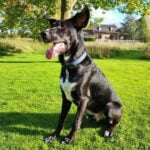Know About The German Shepherd Dalmatian Mix (2024)

The German Shepherd Dalmatian Mix, also known as the Dalmatian German Shepherd Mix by some people, is a unique and fascinating hybrid breed that combines the characteristics of the German Shepherd and the Dalmatian. This mixed designer breed inherits traits from both its parent breeds, which makes the breed very loyal, intelligent, and energetic.
In this comprehensive guide, we will delve deeper into the origins, characteristics, temperament, physical appearance, training and exercise requirements, health considerations, grooming needs, feeding and nutrition, living with a German Shepherd Dalmatian Mix, finding and choosing one, and the associated costs. Whether you’re considering adopting one, already have this designer mix, or simply want to see what the breed looks like, this article will expose you to the world of the Dalmatian German Shepherd mix.
Dalmatian German Shepherd Mix – Key Information
| Characteristics | Range |
|---|---|
| Weight | 60 – 80 pounds |
| Height | 22 – 26 inches |
| Lifespan | 10 – 12 years |
| Coat Colors | Panda, tan, sable, black, white, spotted, mottled |
| Temperament | Highly intelligent, active, loyal & loving |
| Most Suitable For |
|
What Does a Dalmatian German Shepherd Mix Look Like?
Before we move on to some other things you need to know about this designer breed, let’s check out what a Dalmatian German Shepherd Mix looks like, including pictures of the breed.
As with any mixed breed, the appearance of individual dogs may vary based on the traits inherited from each parent. However, there are certain common features that you can expect to find in this delightful mix.
- Coat Colors: One of the most eye-catching aspects of the Dalmatian German Shepherd Mix is its coat colors and patterns. The coat can come in a variety of colors, including panda (black and white), tan, sable, black, white, spotted, and mottled. The classic Dalmatian spots can be found on a German Shepherd-like base, creating a stunning and distinctive coat pattern that sets them apart from other breeds. Some individuals may have more prominent Dalmatian spots, while others may exhibit more German Shepherd-like markings.
- Size and Build: In terms of size, this German Shepherd Dalmatian mix is generally medium- to large-sized, with adult dogs typically weighing between 60 and 80 pounds and standing around 22 to 26 inches tall at the shoulder. Their build is typically athletic and well-proportioned, reflecting the strength and agility of both parent breeds. They have a sturdy and muscular frame, which contributes to their impressive appearance.
- Body Structure: The Dalmatian German Shepherd Mix usually inherits the strong and well-defined body structure of the German Shepherd, with a deep chest, straight back, and a level topline. Their legs are straight and powerful, enabling them to move gracefully and efficiently. The tail is usually medium in length and may have a slight curve, similar to that of the German Shepherd.
- Ears and Eyes: The ears of this mix are often medium to large in size and may be set high on the head. They are usually erect or semi-erect, similar to those of the German Shepherd. As for their eyes, they tend to be medium-sized and expressive, exuding intelligence and alertness. Eye colors may vary, but brown is the most common.
- Expression and Gaze: The Dalmatian German Shepherd Mix typically possesses an intelligent and keen expression. Their gaze is attentive and perceptive, showcasing their high level of intelligence and eagerness to interact with their surroundings. They have a confident and self-assured demeanor, which makes them excellent watchdogs and guardians.
- Gait: When in motion, the German Shepherd Dalmatian mix exhibits a smooth, purposeful, and effortless gait. Their movement is coordinated, and they carry themselves with grace and poise, further highlighting their elegant appearance.
A Brief History of the German Shepherd Breed
The German Shepherd, also known as the Alsatian, is a remarkable and highly versatile breed with a rich history dating back to the late 19th century. Its origin is credited to a German cavalry officer named Captain Max von Stephanitz, who is considered the father of the German Shepherd breed. Von Stephanitz was looking for a dog that was intelligent, strong, and loyal, and he believed that he could create such a dog by breeding the best of the best German herding dogs.
Von Stephanitz found his ideal dog in a male named Horand von Grafrath. Horand was a wolf-like dog with a strong build and keen intelligence. Von Stephanitz purchased Horand and began breeding him with other dogs that he believed had the desired qualities. Over time, von Stephanitz’s breeding program produced a new breed of dog that he called the Deutscher Schäferhund, or German Shepherd Dog.
The German Shepherd was originally bred as a herding dog, but it quickly became clear that the breed had many other talents. German Shepherds were soon being used as police dogs, military dogs, and search-and-rescue dogs. The breed also became popular as a family pet thanks to its loyalty, intelligence, and trainability.
German Shepherds have played an important role in history. They served in both World War I and World War II, and they were used to track down criminals and rescue people from danger. German Shepherds have also been featured in many movies and television shows, which has helped to make the breed even more popular.
A Brief History of the Dalmatian Breed
The Dalmatian is an ancient breed of dog, with its origins dating back to at least 2000 BC. The earliest known depictions of spotted dogs appear in Greek friezes and tablets, showing them working with the chariots of ancient Greece, Rome, and Egypt.
The breed’s name is thought to come from the region of Dalmatia, in present-day Croatia. However, there is no definitive evidence that the breed actually originated there. It is more likely that the name simply reflects the fact that Dalmatians were commonly found in that region.
In the 16th century, Dalmatians began to be used as carriage dogs in England. Their strong and athletic build made them well-suited for this role, and their distinctive appearance made them popular status symbols. Dalmatians were often seen accompanying coaches and carriages, and they became known as “coach dogs” or “firehouse dogs.”
In the 19th century, Dalmatians began to be used as firehouse dogs. Their keen sense of hearing and sight made them excellent watch dogs, and they were also used to pull fire engines. Dalmatians continued to serve as firehouse dogs until the mid-20th century, when they were replaced by motorized fire engines.
Today, Dalmatians are popular pets and show dogs. They are known for their energetic and playful personalities, and they make loyal and loving companions. So, you can imagine cross-breeding a German Shepherd and a Dalmatian. You will surely have a highly intelligent designer breed that will perfectly serve as a hunting, herding, and watchdog.
Why Cross a German Shepherd with a Dalmatian?
We are quite aware that the deliberate breeding of hybrid dogs has its advantages and disadvantages. There are several reasons why people might choose to cross a German Shepherd and a Dalmatian:
- To achieve a desirable trait combination: One of the primary motivations for creating mixed breeds is to combine the desirable traits of both parent breeds. German Shepherds are renowned for their intelligence, loyalty, and versatility, making them excellent working dogs and family companions. Dalmatians, on the other hand, are known for their striking coat patterns and playful nature. By crossbreeding the two, breeders hope to produce dogs that embody the best characteristics of both breeds.
- Unique appearance: The German Shepherd Dalmatian Mix has a unique and eye-catching appearance due to its diverse coat colors and patterns. The combination of the German Shepherd’s base coat and the Dalmatian’s spots results in a visually striking and individualistic appearance that sets them apart from purebred dogs.
- Health considerations: Some breeders and enthusiasts believe that crossbreeding can lead to increased genetic diversity, which may potentially reduce the risk of inherited health issues that are common in purebred dogs. This phenomenon is known as hybrid vigor or heterosis, and it suggests that crossbred dogs may have a lower risk of certain genetic health problems.
- Energetic and active companions: Both the German Shepherd and the Dalmatian are energetic and active breeds that require regular exercise and mental stimulation. The crossbreed inherits this high energy level and can be an excellent choice for families or individuals with an active lifestyle who can provide them with the necessary physical and mental activities.
- Family and guardian instincts: Both parent breeds have strong protective and guardian instincts. German Shepherds are often used as police and military dogs due to their loyalty and protective nature, while Dalmatians historically served as guard dogs for firehouses. The crossbreed may inherit these instincts, making them reliable watchdogs and loyal family protectors.
- Companionship: The Dalmatian German Shepherd Mix can be a loyal and devoted companion. Their affectionate nature and tendency to form strong bonds with their human family members make them excellent pets for those seeking a close relationship with their dogs.
- Versatility: German Shepherds are highly versatile dogs known for their ability to excel in various roles, such as service work, search and rescue, herding, and protection. Dalmatians are also versatile and have been used in various roles, including firefighting and coaching. The crossbreed may exhibit a combination of these versatile traits, making them adaptable to different environments and tasks.
How Popular is the German Shepherd Dalmatian Mix in the United States?
To be frank with you, the German Shepherd Dalmatian Mix is not a very popular dog breed in the United States. According to the American Kennel Club (AKC), the German Shepherd is the 2nd most popular breed in the US, while the Dalmatian is the 56th most popular breed. This means that there are many more German Shepherds and Dalmatians in the US than there are German Shepherd Dalmatian Mixes.
Reasons Why the Dalmatian German Shepherd Mix is Rare in the United States
There are a few reasons why the German Shepherd Dalmatian Mix is not as popular as other crossbreeds. First, both German Shepherds and Dalmatians are relatively large dogs, so the German Shepherd Dalmatian Mix is also likely to be large. This can be a total turn-off for some people who are looking for a smaller dog.
Secondly, both German Shepherds and Dalmatians are active dogs, so the German Shepherd Dalmatian Mix is also likely to be high-energy, and not many dog lovers can keep up with that hyper-energetic breed because they will need a lot of exercise.
Finally, the German Shepherd Dalmatian Mix is a relatively new crossbreed, so there is not as much information available about the breed as there is for other, more established crossbreeds. This can make it difficult for people to decide if the breed is right for them.
How Important is a Dog’s Temperament to your Family?
A dog’s temperament is of paramount importance when considering a new addition to your family. Temperament refers to a dog’s natural disposition, behavior, and emotional responses to various situations and stimuli. A well-suited temperament can enhance the overall experience of dog ownership and ensure a harmonious relationship between the dog and family members. So, here are several reasons that highlight the significance of a dog’s temperament:
- Compatibility: Each family has its own unique lifestyle, routines, and preferences. A dog with a compatible temperament can adapt to and thrive in the family’s environment. For example, an active and outgoing family might find joy in a breed such as a German Shepherd Dalmatian Mix with an energetic and sociable temperament, while a quieter household may prefer a more laid-back and calm canine companion.
- Safety: A dog’s temperament directly impacts the safety of family members, especially if there are children or elderly individuals in the household. A well-balanced and even-tempered dog is less likely to exhibit aggressive or unpredictable behavior, reducing the risk of accidents or injuries. Which is why we don’t recommend owning a Dalmatian German Shepherd Mix if you have kids or elderly people in your family.
- Bonding and Companionship: Dogs with a friendly, affectionate, and loyal temperament form strong bonds with their human family. A dog that enjoys human interaction and seeks companionship can bring immense joy and emotional support to family members.
- Training and Socialization: A dog with a good temperament is generally easier to train and socialize. Positive training methods can be more effective with a dog that is receptive, eager to please, and able to cope well with various social situations.
- Stress Reduction: A calm and well-mannered dog can have a positive impact on the overall stress levels within the family. A dog with a steady temperament can provide comfort and emotional stability during challenging times.
We at Pawsitive Tips strongly advise any prospective dog owners to thoroughly research and understand the typical temperament of the breed or mix they are considering before buying or adopting.
What is the Temperament of the Dalmatian German Shepherd Mix?
Just like we mentioned earlier, the temperament of the Dalmatian German Shepherd Mix is influenced by the characteristics of both parent breeds: the German Shepherd and the Dalmatian. But certain traits are commonly observed in this mix, and they include:
- Intelligent: Both the German Shepherd and the Dalmatian are highly intelligent breeds, and the mix often inherits this trait. Intelligent dogs are quick learners and can excel in training, making them ideal for families seeking a trainable and responsive companion.
- Loyal and Protective: Both parent breeds are known for their loyalty and protective instincts, and these traits often carry over to the mix. Dalmatian German Shepherd Mixes can develop strong bonds with their families and act as reliable guardians when needed.
- Energetic and Active: We can’t stop emphasizing this point. This mix typically has a high energy level, requiring regular exercise and mental stimulation. Families with an active lifestyle or those who enjoy outdoor activities will find a great companion in the Dalmatian German Shepherd Mix.
- Playful and Affectionate: The mix’s playful and affectionate nature makes them excellent companions for families with individuals seeking a loving and interactive pet.
- Socialization: Early and consistent socialization is essential for this mix. Proper socialization helps ensure they are well-adjusted and friendly towards other animals and strangers.
Training and Exercise Requirements Dalmatian German Shepherd Mix
Training Tips
Due to their intelligence and eagerness to please, German Shepherd Dalmatian Mixes are generally receptive to training. However, consistent and positive reinforcement methods are crucial to achieving the best results. Early obedience training and socialization are especially important to prevent behavioral issues in the future.
Exercise Needs
As we’ve pointed out earlier, this mix is an energetic breed that requires regular exercise to stay happy and healthy. Daily walks, playtime, and engaging activities will help meet their physical and mental stimulation needs. A tired dog is often a well-behaved dog, so providing ample exercise can also reduce the likelihood of destructive behaviors.
What are the Common Health Issues with the Dalmatian German Shepherd Mix?
We know that one of the reasons for crossbreeding is to avert some of the health challenges most breeds face, but even at that, there are still some common health issues that may affect the German Shepherd Dalmatian Mix:
- Hip Dysplasia: Hip dysplasia is a common orthopedic condition where the hip joint does not develop correctly, leading to discomfort, pain, and reduced mobility. Both German Shepherds and Dalmatians are known to be susceptible to hip dysplasia, and this risk can carry over to their mix.
- Elbow Dysplasia: Similar to hip dysplasia, elbow dysplasia is a hereditary condition affecting the elbow joint. It can lead to lameness and arthritis over time. This condition can also be passed on to the mix from the parent breeds.
- Deafness: Dalmatians are prone to congenital deafness, and this trait may be inherited by the mix. Regular hearing tests are recommended, especially in Dalmatian German Shepherd Mixes with predominantly white coat coloration.
- Eye Problems: Both parent breeds are susceptible to certain eye issues, including progressive retinal atrophy (PRA), cataracts, and glaucoma. Regular eye check-ups by a veterinarian can help detect and address these conditions early.
- Skin Issues: Dalmatians are known to be prone to skin allergies and sensitivities. This susceptibility may carry over to the mix, necessitating appropriate grooming and attention to their skin health.
- Urinary Stones: Dalmatians have a unique metabolism that can lead to the formation of urinary stones, specifically urate stones. Ensuring proper hydration and a balanced diet can help minimize the risk of this condition.
- Bloat (Gastric Dilatation-Volvulus): Large and deep-chested breeds, such as the German Shepherd, can be prone to bloat, a life-threatening condition where the stomach twists. Prompt veterinary attention is crucial if bloating is suspected.
- Heart Issues: Dilated cardiomyopathy (DCM) and other heart conditions can affect both parent breeds, and there may be a risk of inheriting such heart issues in the mix.
How Do you Groom a German Shepherd Dalmatian Mix?
Grooming a German Shepherd Dalmatian Mix requires regular maintenance to keep their coat and skin healthy, manage shedding, and ensure overall cleanliness. Since the mix can inherit traits from both parent breeds, grooming practices may vary depending on their coat type and length. So, let’s look at the grooming needs for a German Shepherd Dalmatian Mix here:
Brushing
The mix has a short to medium-length coat, and regular brushing is essential to remove loose hair, dirt, and debris.
- Use a slicker brush or a grooming mitt to gently brush their coat, paying attention to the areas where the undercoat is more prominent, such as the neck, chest, and hindquarters.
- During shedding seasons, such as spring and fall, more frequent brushing will help manage the increased hair loss.
Bathing
- Bathe your German Shepherd Dalmatian Mix as needed; we recommend bathing your dogs every 4 to 6 weeks, or when they get dirty or smelly.
- Use a dog-specific shampoo that suits their coat type and avoid over-bathing, as it can strip their coat of natural oils, leading to dry skin.
Ear Cleaning
- Check their ears regularly for dirt, wax buildup, or signs of infection.
- Gently clean their ears using a veterinarian-recommended ear cleaner and a soft cotton ball. Avoid using cotton swabs to prevent injury.
Dental Care
- Brush their teeth regularly, ideally daily, using a dog-specific toothbrush and toothpaste to maintain good dental hygiene.
- Dental chews or toys can also help reduce tartar buildup and maintain oral health.
Nail Trimming
- Trim your Dalmatian German Shepherd Mix’s nails regularly to prevent overgrowth, which can cause discomfort and affect their gait.
- Be cautious not to cut too close to the quick, which is a blood vessel inside the nail.
Anal Gland Expression
Some dogs, including the German Shepherd Dalmatian Mix, may require periodic anal gland expression if they do not naturally empty them during bowel movements. This procedure is typically done by a veterinarian or professional groomer.
Regular Checkups
Schedule regular checkups with a veterinarian to monitor your dog’s overall health, including their skin and coat condition.
Shedding Management
Both German Shepherds and Dalmatians can shed quite a bit, so be prepared for regular shedding.
During heavy shedding seasons, using a deshedding tool can help reduce loose hair.
Exercise and Diet
Regular exercise and a balanced diet contribute to a healthy coat and skin. Make sure your dog gets enough physical activity and is fed a nutritionally balanced diet suitable for their age and activity level.
Diet Plan For a Dalmatian German Shepherd Mix
Dalmatian German Shepherd Mix dogs are active and need a diet that reflects that. They should eat a high-protein, low-fat diet of about 3 cups of food divided into two meals per day. If your dog is old or inactive, they may need less food.
Here are some tips for feeding your Dalmatian German Shepherd Mix a healthy diet:
- Don’t overfeed your dog with treats. Treats should only make up 5% of their daily calorie intake.
- Avoid feeding your dog human food. It can upset their stomach and cause gas.
- Talk to your vet about the best diet for your dog. They can help you create a plan that meets your dog’s individual needs.
You may also want to check out the Best time to feed dogs so they don’t poop at night.
Finding and Choosing a German Shepherd Dalmatian Mix
Because the breed isn’t that popular in the United States, finding and adopting one can be very frustrating. But here are several steps you can take to help you find and bring home a new German Shepherd Dalmatian Mix in the United States:
Make Findings from Local Shelters
Start by researching local animal shelters, rescue organizations, and humane societies in your area. They may have German Shepherd Dalmatian Mixes available for adoption. Check their websites or visit the shelters in person to see the dogs in person.
Use Online Adoption Platforms
Use online adoption platforms like Petfinder, Adopt-a-Pet, and Rescue Me to search for available German Shepherd Dalmatian Mixes in your region. These websites often have comprehensive listings and allow you to filter your search based on location and breed.
Use a Breed-Specific Rescue groups
Look for breed-specific rescue groups that focus on German Shepherds, Dalmatians, or mixed breeds. These rescues may occasionally have German Shepherd Dalmatian Mixes available for adoption.
Attend Adoption Events
Check for local adoption events or pet fairs in your area. These events are an excellent opportunity to meet rescue organizations and interact with dogs available for adoption.
Visit Animal Shelters
Visit nearby animal shelters and humane societies regularly, as new dogs become available for adoption all the time. Be patient, as finding the right match may take time.
Contact Local Veterinarians
Personally, I have adopted quite a number of small dogs through my local veterinarian. So, reach out to the ones in your area and ask if they are aware of any German Shepherd Dalmatian Mixes in need of a loving home. They might have leads on dogs in need of adoption.
Networking and Social Media
Spread the word among friends, family, and on social media that you are looking to adopt a German Shepherd Dalmatian Mix. Join different Facebook groups and pages for dog adoption. Who knows? You may be lucky to get one through them. Sometimes, word of mouth can also lead to discovering dogs in need of a forever home.
Related articles:
- Where Can I Donate My German Shepherd For Service?
- How to Celebrate National Dog Day ( A Must Read)
- Blue Bay Shepherds Mix
How Much Does a German Shepherd Dalmatian Mix Cost in the United States?
The cost of a German Shepherd Dalmatian Mix dog in the United States can vary depending on a number of factors, including the breeder, the dog’s age, and its health. However, in general, you can expect to pay anywhere from $300 to $1,000 for a German Shepherd Dalmatian Mix puppy.
Does the Dalmatian German Shepherd Mix Shed?
Yes, the Dalmatian German Shepherd Mix may shed, as both the Dalmatian and the German Shepherd breeds are known to shed. The frequency and amount of shedding can vary depending on the individual dog and their coat type. Like we highlighted above, regular brushing can help manage shedding and keep their coat healthy.
How Much Exercise Does A Dalmatian German Shepherd Mix Need?
Dalmatian German Shepherd Mixes are high-energy dogs that require at least 45 minutes to 2 hours of exercise per day. This can include a combination of walking, running, playing fetch, and other activities. If you are not able to provide your dog with this amount of exercise, they may become bored, destructive, or even aggressive.
How Long Can a Dalmatian German Shepherd Mix Live?
The average lifespan of a Dalmatian German Shepherd Mix is 10 to 12 years. However, some dogs may live longer or shorter than this.
Recommended Dog Beds For a Dalmatian German Shepherd Mix
Once you’ve managed to adopt or buy a beautiful Dalmatian German Shepherd Mix puppy, we recommend getting any of these dog beds for your dog to relax and sleep in.
Recommended Food For a German Shepherd Dalmatian Mix
If you intend buying the best nutritional meals for your Dalmatian German Shepherd Mix, below are the best brands to go with:
Royal Canin Dog Food
This food is specifically formulated for German Shepherds and contains all the nutrients they need to stay healthy. It is also high in protein, which is important for active dogs like German Shepherd Dalmatian.
Blue Buffalo Dog Food
Blue Buffalo is a popular brand of natural dog food that is made with high-quality ingredients. The company offers a variety of formulas for different life stages and breeds, as well as wet and dry food options.
WeFeedRaw Wet Dog Food
WeFeedRaw is a company that delivers human-grade raw, frozen dog food to your door.
Raw Paws Pet Food
Just like the WeFeedRaw Wet dog food, Raw Paws Pet Food is another company that sells human-grade frozen, raw pet food.
So, that’s it guys! This is all you need to know about a German Shepherd Dalmatian Mix. If you have any further questions, please leave a comment below.



